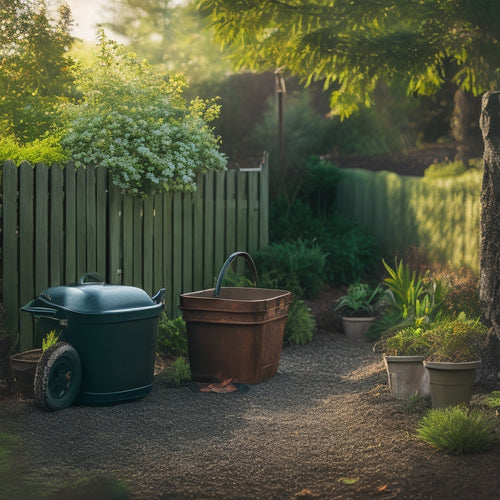
Solar-Powered Hub: Charge Your Garden Tools Outdoors
Share
You're considering a solar-powered hub to charge your garden tools outdoors, and that's a great idea! By utilizing renewable energy, you'll reduce your environmental impact, save on costs, and eliminate the worry of running out of power mid-task. When choosing a station, think about the solar panel type, size, and placement for maximum sunlight exposure. You'll want to ascertain compatibility with your tools, consider energy efficiency, and assess power source options. With the right setup, you can enjoy uninterrupted gardening sessions while doing your part for the planet - and there's more to investigate to get the most out of your solar-powered hub.
Key Takeaways
- Consider the type and size of solar panels, as well as the station's placement, to optimize charging efficiency and meet specific gardening needs.
- Ensure the solar-powered hub is compatible with a variety of garden tools, has multiple power source options, and prioritizes energy efficiency to reduce waste.
- Choose a hub with high-capacity batteries, high-quality solar panels, and a high charging efficiency to minimize downtime during gardening tasks.
- Maximize energy efficiency by minimizing energy waste, implementing energy-harvesting technologies, and leveraging solar technology to reduce reliance on traditional power.
- Consider outdoor storage and security options, such as locking mechanisms and durable designs, to protect tools from theft and harsh weather conditions.
Benefits of Solar Charging
Many homeowners rely on a variety of garden tools to maintain their outdoor spaces, but these tools often require frequent recharging.
You're likely tired of being tethered to a power outlet or dealing with dead batteries. That's where solar charging comes in. By capturing the sun's energy, you can reduce your environmental impact and enjoy cost savings.
With solar charging, you'll never have to worry about running out of power mid-task again. Plus, you'll be doing your part for the planet by reducing your reliance on fossil fuels, which account for significant global emissions renewable energy solutions and dramatically reducing greenhouse gas emissions.
Choosing the Right Station
You've decided to make the switch to solar charging, but now it's time to reflect on where you'll store and charge your garden tools. This is where choosing the right station comes in. You'll want to contemplate the type of solar panel, the size of the station, and its placement in your yard.
| Solar Panel Type | Station Size | Station Placement |
|---|---|---|
| Monocrystalline | Small (1-2 tools) | South-facing wall or fence |
| Polycrystalline | Medium (2-4 tools) | Partially shaded area |
| Thin Film | Large (4-6 tools) | Full sun exposure |
| Monocrystalline | Extra Large (6+ tools) | Rooftop or mounted pole |
| Polycrystalline | Compact (1 tool) | Tabletop or bench |
When selecting a station, reflect on the number of tools you need to charge and the amount of sunlight your yard receives. By contemplating these factors, you'll find a station that meets your needs and provides the freedom to work in your garden without worrying about battery life.
Design and Installation Tips
With your solar-powered hub for garden tools selected, it's time to focus on the design and installation process.
You'll want to take into account aesthetic considerations, such as the hub's color and style, to guarantee it blends seamlessly with your outdoor space. High-efficiency solar panels can increase energy yield greatly, reducing surface area requirements smart charging algorithms and allowing for a more compact design.
When it comes to installation, follow the manufacturer's guidelines to guarantee a safe and efficient setup. Typically, this involves finding a spot with ideal sunlight, mounting the hub, and connecting the charging cables.
Make certain to secure the cables to prevent tripping hazards and protect them from the elements. By following these installation guidelines, you'll be able to enjoy a convenient and eco-friendly charging experience for your garden tools.
Compatibility With Garden Tools
You'll want to confirm your solar-powered hub supports a variety of garden tools, from pruners to hedge trimmers, to maximize its usefulness.
The hub should also offer multiple power source options, such as USB ports and battery packs, to accommodate different tool requirements.
When selecting a hub, take into account the energy efficiency high-efficiency solar panels to reduce energy waste and minimize your carbon footprint.
Additionally, you'll need to take into account the charging speed to minimize downtime and keep your gardening tasks on track.
Tool Variety Support
Selecting the right solar-powered hub for your garden tools means ensuring it can accommodate a variety of tools, making your gardening experience more efficient and enjoyable.
You'll want a hub that supports a range of voltages and ampere-hours to cater to different tool types, from trimmers to blowers. This versatility will save you time and effort in tool maintenance.
Additionally, considering renewable energy solutions like solar panels on fleet vehicles can reduce fossil fuel reliance and carbon footprint, making your gardening routine even more eco-friendly.
Look for a hub that's compatible with popular garden tool brands and models, ensuring seamless integration and minimizing the risk of battery damage.
A hub that supports multiple tools will also help extend battery lifespan, reducing the need for frequent replacements and keeping your gardening routine uninterrupted.
With the right tool variety support, you'll be free to focus on nurturing your garden, not worrying about your tools.
Power Source Options
When it comes to choosing a solar-powered hub for your garden tools, the type of power source options available can greatly impact your overall gardening experience.
You'll want to take into account the type of battery that comes with the hub, as different battery types offer varying levels of power and durability. Look for hubs with high-capacity batteries that can store excess energy for cloudy days or extended tool use.
Additionally, reflect on the quality and efficiency of the solar panels that charge the battery, such as those designed for trucks, focusing on durability and efficiency renewable energy sources.
By utilizing free, renewable energy, you can reduce your reliance on fossil fuels and minimize your carbon footprint.
Charging Speed Matters
Most gardeners have a suite of tools they rely on, from trimmers to pruners, and a solar-powered hub that can't keep up with their charging needs can be a significant hindrance.
You need a hub that can efficiently charge your tools, so you can get back to your gardening tasks. Charging speed matters, and a solar-powered hub with high charging efficiency is essential.
Look for a hub with solar panels that can capture maximum energy from the sun, ensuring your tools are charged quickly. This way, you can enjoy uninterrupted gardening sessions, without worrying about running out of power.
With a fast-charging solar hub, you'll have the freedom to work in your garden, whenever you want, without any constraints.
Maximizing Energy Efficiency
As you design your solar-powered hub for garden tools, optimizing energy efficiency becomes essential to guarantee your system can power all your tools reliably.
You'll want to minimize energy waste and maximize energy conservation. One way to do this is by selecting energy-efficient tools that consume less power.
Additionally, consider using energy-harvesting technologies that can store excess energy for later use. By leveraging solar technology, you can reduce your reliance on traditional power sources and enjoy the freedom to work in your garden without worrying about running out of power.
Outdoor Storage and Security
You'll want to contemplate secure storage options for your solar-powered hub to protect your garden tools from theft or damage.
Effective tool protection measures can include features like locking compartments, anchor points, and weather-resistant materials.
Secure Storage Options
During those moments when you're not tending to your garden, your solar-powered hub's storage capacity becomes essential in keeping your tools organized and safe from the elements and potential theft.
You need a secure storage solution that protects your precious equipment from harsh weather conditions and unauthorized access.
Look for a hub with:
- Weatherproof materials that can withstand rain, snow, and extreme temperatures
- Locking mechanisms that prevent theft and tampering
- A durable design that can support the weight of your tools and accessories
Tool Protection Measures
Beyond the hub's walls, your tools face exposure to the elements and potential theft. You'll want to take measures to protect them.
Look for outdoor storage solutions with weather-resistant materials that can withstand rain, snow, and direct sunlight. Durable materials like heavy-duty plastics, metals, or recycled materials can provide an added layer of security.
Consider investing in a storage unit with lockable compartments or a shed with a secure door. This will prevent unauthorized access and keep your tools safe from prying eyes.
Frequently Asked Questions
Can I Use My Solar-Powered Hub During Cloudy or Rainy Days?
You can still use your solar-powered hub on cloudy or rainy days, but expect reduced performance due to cloud coverage effects on solar efficiency factors, resulting in slower charging times or lower power output.
How Long Does It Take to Fully Charge My Garden Tools?
Imagine you're preparing for a garden party and need to charge your cordless trimmer; depending on the battery capacity, it'll take around 2-4 hours to fully charge, so plan ahead to guarantee you're ready to go when guests arrive.
Are Solar-Powered Hubs Compatible With Electric Bicycles?
You're wondering if solar-powered hubs are compatible with electric bicycles? Yes, they are! Most solar hubs offer universal charging ports, making them compatible with electric bicycles, giving you the freedom to charge on-the-go with solar power.
Can I Leave My Solar-Powered Hub Outside Year-Round?
You're wondering if your new outdoor buddy can brave the elements 24/7? Absolutely! Look for weather-durable hubs and follow installation tips to guarantee a snug, secure fit - then, enjoy the freedom to charge on, rain or shine!
Do Solar-Powered Hubs Have Surge Protection for My Tools?
You'll want to guarantee your solar-powered hub has surge protection to safeguard your tools from power spikes, providing tool safety and peace of mind, so look for a hub with built-in surge protection or consider a separate surge protector.
Related Posts
-

3 Green HVAC Filters for Solar-Powered Homes
When outfitting your solar-powered home with an HVAC system, you'll want to choose filters that align with your commi...
-

10 Green Waste Solutions Every Homeowner Should Know
You can make a significant impact on the environment by implementing green waste solutions at home. Consider composti...
-

7 Top HEPA Filters for Green Building Projects
You need a reliable HEPA filter for your green building project that aligns with your sustainable goals and guarantee...


